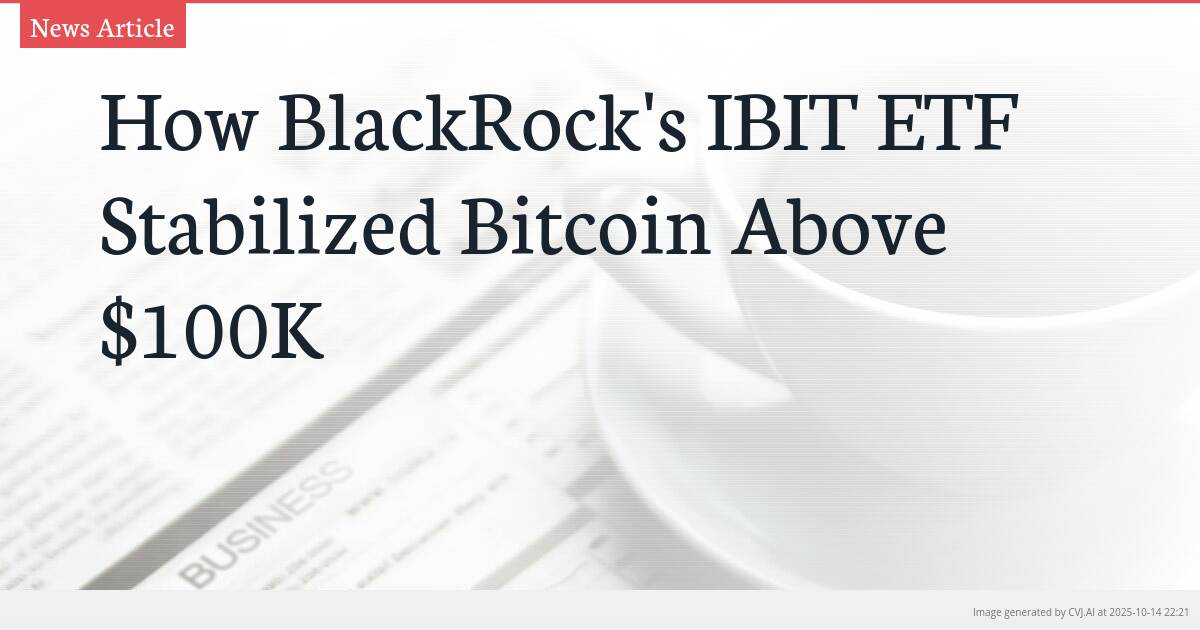This summary text is fully AI-generated and may therefore contain errors or be incomplete.
Introduction
Bitcoin experienced extreme volatility over the weekend, plunging through $110,000 amid tariff tensions before recovering. The key question emerging from the turmoil is whether BlackRock’s IBIT ETF acted as a critical shock absorber, preventing a deeper price collapse. Analysis of ETF flows reveals a fascinating structural dynamic at play.
Key Points
- IBIT recorded net inflows of $74.2M and $60.4M on key volatility days while most competing ETFs saw outflows
- Early October saw record ETF inflows exceeding $1.2B daily, creating a buffer of newly created shares before the selloff
- The $7B liquidation event was primarily driven by derivatives positions rather than ETF redemptions, with ETF flows showing minimal net outflows
The Weekend Volatility and ETF Response
Bitcoin’s recent price action demonstrated classic macro-driven volatility, with Friday’s tariff threats toward China sending risk assets tumbling and pushing BTC through $110,000. The selloff triggered approximately $7 billion in crypto position liquidations as leverage unwound into thin market conditions. However, by Sunday night and into Monday, the tone softened as former President Trump posted calming messages about China, allowing US markets to steady and China ADRs to bounce. Bitcoin followed with a morning recovery, retracing part of the weekend slump.
The critical question arising from this volatility was whether the US spot ETF complex, particularly BlackRock’s IBIT, functioned as a stabilizing force that prevented Bitcoin from sliding deeper. Early last week, US spot Bitcoin ETFs had recorded a blockbuster run, with October 6 alone clearing roughly $1.21 billion in net inflows – the largest single-day print in months. This substantial inflow occurred before the tariff headlines, indicating that cash was already queued up and flowing into wrapped BTC exposure.
When the market flush occurred on Friday, if ETFs had been structurally brittle, one would have expected a cascade of same-day redemptions. Instead, Farside’s daily flow data showed aggregate US spot-BTC ETF flows finishing October 10 with just $4.5 million in outflows – a remarkably small figure given the market turmoil. This minimal outflow during a period of significant stress suggested the ETF structure was functioning as intended rather than amplifying the selloff.
IBIT's Counterbalancing Role in Market Stress
Beneath the surface of the aggregate ETF flows, BlackRock’s IBIT told a different story than its peers. While most competing ETFs experienced outflows on October 10, IBIT pulled in $74.2 million in net inflows. This divergence matters because it demonstrates the ETF market didn’t act in unison during the stress event. Some holders requested cash back from smaller funds, yet the largest fund continued creating shares and pulling coins into custody.
The pattern intensified on Monday, October 13, when the split widened further. The broader ETF cohort experienced $326.4 million in outflows, yet IBIT again recorded net creations of $60.4 million. Mapping this against price action provides a clearer picture: the market didn’t rally because ETF buyers charged in across the board, but rather stabilized while the single largest product continued to intake coins as others bled. This dynamic doesn’t make IBIT a magical price floor, but it does explain why the weekend washout failed to snowball into a fast break below $100,000 once headlines cooled.
The structural mechanics of ETF operations further supported this stabilization. ETF redemptions don’t trigger instant selling on exchanges, as authorized participants handle the process by swapping baskets and hedging exposure through futures and spot markets. On October 10, the small net outflow across all funds likely created some short-term selling pressure as APs balanced books, but IBIT’s inflows worked in the opposite direction. The result was a relatively neutral street position rather than one-sided hedging, which helped Bitcoin stabilize once broader market sentiment improved.
Structural Insights and Market Implications
The weekend’s events revealed several critical insights about Bitcoin’s evolving market structure. First, the buyer base is clearly segmented. When markets turn volatile, not every ETF holder behaves identically. On both October 10 and 13, IBIT recorded net creations while peers booked redemptions, consistent with a holder mix that tolerates drawdowns inside the largest, lowest-fee vehicle while smaller funds experience faster churn. For price stability, the net effect on the primary market matters most, and on the worst day, the cohort’s net outflow was trivial in size and partially offset by IBIT intake.
Second, pre-shock inflows significantly changed the starting conditions. The early-October surge meant custodians were already sitting on newly created shares heading into Friday’s volatility. This inventory acted as ballast, as holders needed to actively choose to redeem to translate market stress into primary-market selling. The flow data shows many did not exercise this option, and where redemptions occurred, IBIT’s concurrent creations blunted the impact.
Third, derivatives still drove the majority of the selling pressure. The $7 billion liquidation event came primarily from forced position cuts in leveraged derivatives, not ETF panic. The ETF tape added texture to the story: a small net negative on Friday, a larger net negative on Monday, and a persistent counter-flow at IBIT. This pattern helps explain why Bitcoin didn’t cascade through $100,000 when the macro shock hit and why the market had room to bounce once the policy tone from the United States toward China cooled.
📎 Read the original article on cryptoslate.com

